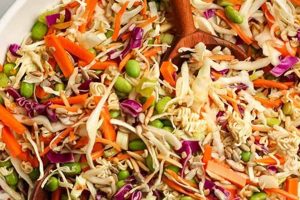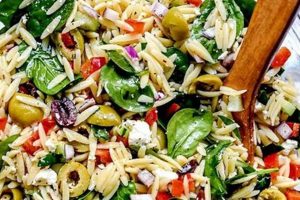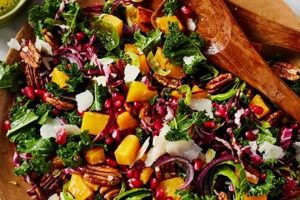Salads encompass a wide range of culinary creations, from simple leafy greens tossed with a vinaigrette to complex compositions incorporating grains, proteins, fruits, and vegetables. Examples include classic Caesar salad, vibrant Greek salad, and hearty Cobb salad, each characterized by unique ingredients and dressings. The possibilities are virtually limitless, allowing for customization based on dietary needs, seasonal availability, and personal preferences.
The versatility of salads contributes to their significance in a balanced diet. They offer a readily accessible means of consuming essential vitamins, minerals, and fiber. Historically, salads have evolved from simple herb-based dishes to the diverse array of options available today, reflecting culinary innovations and cultural influences. Their adaptability makes them suitable as light lunches, appetizers, or side dishes, contributing to a broader, healthier dietary landscape.
This article will explore specific salad categories, including green salads, pasta salads, fruit salads, and bound salads, delving into ingredient selection, dressing preparation, and nutritional considerations. It will also address the art of balancing flavors and textures to create appealing and healthful meals.
Tips for Creating Diverse and Delicious Salads
Crafting a successful salad involves more than simply tossing ingredients together. Consideration of flavor profiles, textural contrasts, and nutritional balance elevates a simple salad to a culinary masterpiece. The following tips offer guidance for creating a variety of appealing and healthful salads.
Tip 1: Start with Fresh, High-Quality Ingredients: The foundation of any good salad lies in the freshness of its components. Opt for vibrant, seasonal produce and properly stored proteins and grains.
Tip 2: Balance Flavors and Textures: Combine contrasting elements, such as bitter greens with sweet fruits, crunchy nuts with tender vegetables, or creamy cheeses with sharp vinaigrettes. This interplay creates a more dynamic and satisfying experience.
Tip 3: Explore a Variety of Greens: Move beyond basic lettuce. Experiment with spinach, kale, arugula, romaine, or butter lettuce to discover new flavors and textures.
Tip 4: Dress Smartly: Dressings enhance flavor and can tie all the ingredients together. Consider lighter vinaigrettes for delicate greens and creamier dressings for heartier salads. Proper emulsification prevents separation and ensures even coating.
Tip 5: Add Protein Power: Incorporate lean proteins like grilled chicken, fish, beans, lentils, or tofu to create more substantial and satisfying meals.
Tip 6: Don’t Forget the Crunch: Toasted nuts, seeds, croutons, or crispy vegetables add a welcome textural element.
Tip 7: Compose Thoughtfully: Consider the visual appeal of the salad. Arrange ingredients attractively to enhance the dining experience.
By employing these tips, one can transform simple ingredients into flavorful, nutritious, and visually appealing salads suitable for any occasion.
This exploration of salad creation provides a foundation for further culinary experimentation and the development of personalized recipes tailored to individual preferences and dietary needs.
1. Ingredients
Ingredients serve as the defining characteristic of a salad, directly influencing its categorization, flavor profile, nutritional value, and cultural context. The selection and combination of ingredients determine whether a salad qualifies as a light appetizer, a substantial main course, or a refreshing dessert. A Caprese salad, for example, relies on the simple yet impactful combination of fresh mozzarella, tomatoes, and basil, highlighting the Italian emphasis on fresh, high-quality ingredients. In contrast, a Waldorf salad combines apples, grapes, celery, and walnuts, demonstrating a different flavor profile and cultural origin.
The interplay of ingredients contributes significantly to the overall sensory experience. Textural contrasts, achieved through combining crisp lettuce with crunchy nuts or creamy avocado, add complexity. Balancing sweet, sour, salty, and bitter elements, using ingredients like citrus fruits, vinegar, olives, or bitter greens, creates a harmonious flavor profile. Understanding the inherent properties of individual ingredients allows for strategic combinations that enhance both nutritional value and palatability. Adding grilled chicken or fish to a salad provides protein, while incorporating a variety of colorful vegetables increases vitamin and mineral intake.
Ingredient selection also carries practical implications, influencing preparation methods and storage considerations. Delicate greens require gentle handling, while heartier vegetables may benefit from grilling or roasting. Proper storage techniques maintain ingredient freshness and prevent spoilage. Ultimately, a thorough understanding of ingredient selection and combination is essential for creating successful salads that meet specific dietary needs, cultural preferences, and culinary objectives.
2. Dressings
Dressings are integral to salad recipes, acting as more than mere condiments. They contribute significantly to flavor, texture, and overall culinary experience. A well-chosen dressing elevates a simple combination of ingredients into a cohesive and satisfying dish. Understanding the nuances of dressing selection, preparation, and application is essential for successful salad creation.
- Flavor Profiles
Dressings provide an opportunity to introduce diverse flavor profiles, complementing and enhancing the inherent tastes of the salad ingredients. A tangy vinaigrette brightens a salad featuring fresh greens and vegetables, while a creamy ranch dressing complements heartier salads with roasted vegetables or proteins. The interplay of sweet, sour, salty, and bitter notes within a dressing can balance and elevate the overall flavor composition. For instance, a honey mustard dressing balances sweetness with tanginess, while a balsamic vinaigrette offers a complex interplay of sweet and acidic notes. Careful consideration of flavor profiles ensures a harmonious and well-balanced final product.
- Texture and Consistency
Dressings contribute textural complexity to salads. A creamy dressing adds richness and coats ingredients evenly, while a vinaigrette provides a lighter, more refreshing touch. The consistency of a dressing influences the overall mouthfeel and can significantly impact the dining experience. For example, a thick, creamy dressing clings to ingredients, while a thin vinaigrette lightly coats the salad components. The choice of consistency depends on the specific salad ingredients and desired outcome.
- Emulsification and Stability
The stability of a dressing, particularly in emulsions like vinaigrettes, affects both its visual appeal and its ability to coat salad ingredients evenly. Proper emulsification, achieved by combining oil and an acidic element like vinegar or citrus juice, creates a stable mixture that prevents separation. A stable dressing adheres evenly to the salad components, ensuring consistent flavor distribution. Conversely, a poorly emulsified dressing separates, resulting in an uneven coating and a less satisfying culinary experience.
- Cultural Influences
Dressings reflect cultural influences and traditions. A classic French vinaigrette, for example, typically utilizes olive oil, vinegar, and herbs, while an Asian-inspired dressing might incorporate sesame oil, soy sauce, and ginger. These culturally influenced dressings contribute unique flavor profiles and further diversify the salad landscape. Understanding these cultural nuances adds depth and complexity to salad creation.
The interplay of these facetsflavor, texture, stability, and cultural influencedemonstrates the multifaceted role dressings play in defining a salad’s character. By understanding and manipulating these elements, one can elevate a simple salad into a sophisticated and satisfying culinary creation, tailored to specific tastes and preferences.
3. Preparation Methods
Preparation methods significantly influence the final character of a salad, impacting texture, flavor, and overall presentation. Different techniques applied to ingredients contribute to the diversity observed across various salad types. Consider the contrast between a chopped salad, where ingredients are uniformly sized for even dressing distribution and ease of eating, and a composed salad, where ingredients are artfully arranged, emphasizing visual appeal and allowing for distinct flavor experiences with each bite. The choice of preparation method directly correlates with the desired outcome, affecting both the sensory experience and the practical aspects of consumption.
Specific preparation techniques applied to individual ingredients further diversify salad recipes. Grilling vegetables imparts a smoky char and enhances their natural sweetness, as exemplified in grilled romaine salads. Roasting nuts intensifies their flavor and adds a satisfying crunch. Techniques like blanching or marinating can alter the texture and flavor profile of vegetables, influencing the overall salad composition. For instance, blanching green beans preserves their vibrant color and creates a tender-crisp texture, while marinating onions mellows their sharpness and adds depth of flavor. These nuanced applications of preparation methods demonstrate their crucial role in defining the final characteristics of a salad.
Understanding the impact of preparation methods provides a foundation for informed culinary decision-making. Selecting appropriate techniques based on ingredient characteristics and desired outcomes ensures a successful and satisfying salad. Whether the goal is a crisp and refreshing salad with raw vegetables or a warm and hearty salad with roasted components, careful consideration of preparation methods allows for precise control over the final product. This knowledge empowers culinary exploration and enables the creation of diverse and delicious salads tailored to specific preferences and occasions.
4. Cultural Influences
Cultural influences play a significant role in shaping the diversity observed in salad recipes worldwide. Cuisine reflects cultural values, available ingredients, and historical traditions. Salads, despite their seemingly simple nature, exemplify this cultural imprint. The Greek salad, with its emphasis on fresh tomatoes, cucumbers, olives, and feta cheese, reflects the Mediterranean climate and agricultural traditions. Similarly, the use of seaweed and pickled ginger in Japanese salads showcases the importance of marine resources and distinct flavor profiles in Japanese cuisine. These examples illustrate how cultural context dictates ingredient selection and preparation methods, resulting in unique and geographically specific salad variations.
This cultural influence extends beyond mere ingredient choices. Flavor profiles, dressing preferences, and even the concept of what constitutes a “salad” vary across cultures. In some cultures, salads serve as light accompaniments, while in others, they function as substantial main courses. The prevalence of certain herbs, spices, and flavor combinations within salad dressings reflects regional palates and culinary practices. For example, the use of fish sauce in Southeast Asian dressings contrasts sharply with the reliance on olive oil and vinegar in Mediterranean dressings. Understanding these cultural nuances provides valuable insights into the evolution and diversity of salad recipes.
Recognizing the cultural context of salad recipes enhances culinary appreciation and facilitates cross-cultural understanding. It allows for a deeper engagement with culinary traditions and provides a framework for interpreting the diverse flavors and ingredients encountered in salads worldwide. This awareness fosters culinary exploration and encourages the development of innovative recipes that draw inspiration from diverse cultural influences. Ultimately, appreciating the cultural dimension of salads enriches the culinary experience and promotes a more nuanced understanding of global foodways.
5. Nutritional Profiles
Nutritional profiles of salads vary significantly based on ingredient composition and preparation methods. A salad primarily composed of leafy greens offers a different nutritional profile than one featuring pasta, cheese, or fried toppings. Nutrient density, caloric content, and macronutrient ratios shift depending on the specific ingredients selected. A spinach salad with grilled chicken and a light vinaigrette, for instance, provides a good source of protein, iron, and vitamins A and C, while a pasta salad with mayonnaise-based dressing contributes higher levels of carbohydrates and fat. Understanding these variations allows for informed choices aligned with individual dietary needs and goals.
Ingredient selection exerts a primary influence on a salad’s nutritional value. Incorporating nutrient-rich vegetables like kale, broccoli, and bell peppers increases vitamin, mineral, and antioxidant intake. Adding lean protein sources, such as grilled fish or beans, enhances protein content without significantly increasing saturated fat. Conversely, including fried toppings or cheese adds calories and fat. Preparation methods further impact nutritional content. Grilling vegetables can concentrate flavors and nutrients, while excessive boiling may leach water-soluble vitamins. Therefore, mindful ingredient selection and preparation techniques are crucial for maximizing nutritional benefits.
Awareness of nutritional profiles facilitates informed dietary choices. Individuals seeking to increase fiber intake might prioritize salads featuring beans, lentils, and whole grains. Those aiming to reduce calorie consumption can opt for lighter dressings and lean protein sources. Understanding the nutritional implications of different ingredients and preparation methods empowers individuals to customize salads to meet specific dietary requirements and support overall health and well-being. This knowledge translates into practical applications, enabling individuals to make informed decisions when selecting or creating salads that align with their nutritional goals.
6. Serving Occasions
Serving occasions significantly influence the selection and composition of salad recipes. The context of a mealwhether a casual weeknight dinner, a festive holiday gathering, or a summer picnicdictates appropriate salad choices. Factors such as formality, seasonality, and accompanying dishes inform decisions regarding ingredients, preparation methods, and presentation. Understanding the interplay between serving occasions and salad selection allows for curated culinary experiences tailored to specific events and gatherings.
- Casual Meals
Casual meals often call for simple, readily assembled salads. Everyday salads might feature readily available ingredients like mixed greens, chopped vegetables, and a basic vinaigrette. Emphasis is placed on convenience and nutritional value rather than elaborate presentation. These salads often serve as side dishes or light lunches, complementing the main course without overshadowing it.
- Formal Gatherings
Formal gatherings often warrant more elaborate and visually appealing salads. Composed salads with carefully arranged ingredients, such as layered salads or those featuring grilled or roasted components, offer a more refined presentation. Emphasis is placed on aesthetic appeal, flavor complexity, and the use of high-quality ingredients. These salads may serve as appetizers or even as a main course, contributing to the elegance and sophistication of the occasion.
- Seasonal Considerations
Seasonality influences ingredient selection and, consequently, the types of salads appropriate for specific times of year. Summer salads often highlight fresh, vibrant produce like tomatoes, berries, and cucumbers, reflecting the abundance of these ingredients during warmer months. Winter salads might incorporate heartier ingredients like roasted root vegetables, kale, and dried fruits, offering warmth and substance during colder seasons. Adapting salad recipes to seasonal ingredient availability ensures optimal flavor and nutritional value.
- Dietary Restrictions
Dietary restrictions and preferences significantly impact salad choices for specific occasions. When catering to guests with allergies or specific dietary needs, careful consideration must be given to ingredient selection and preparation methods. Vegan salads, gluten-free salads, or those designed for low-sodium diets require specific ingredient substitutions and preparation techniques to accommodate dietary limitations without compromising flavor or satisfaction. Addressing these dietary considerations ensures inclusivity and allows all guests to enjoy the culinary experience.
Considering the serving occasion when selecting or creating a salad ensures a harmonious and appropriate culinary experience. Understanding the context of the meal, the level of formality, seasonal influences, and potential dietary restrictions allows for informed decision-making and the creation of salads that enhance the overall dining experience. This awareness elevates salad preparation beyond mere sustenance, transforming it into a thoughtful and tailored culinary expression.
Frequently Asked Questions
This section addresses common inquiries regarding the diverse world of salad recipes, offering practical guidance and clarifying potential misconceptions.
Question 1: How can one elevate basic salads beyond simple lettuce and tomatoes?
Expanding salad variety involves incorporating diverse ingredients like roasted vegetables, fruits, nuts, seeds, cheeses, and proteins. Experimenting with different greens, such as spinach, kale, or arugula, also adds complexity. Flavorful dressings and creative toppings further enhance the sensory experience.
Question 2: What strategies ensure a well-balanced and flavorful salad?
Balancing flavors and textures is key. Combine contrasting elements like sweet and savory, crunchy and soft, or acidic and creamy. Consider the interplay of ingredients and dressings to create a harmonious flavor profile.
Question 3: What are effective methods for preventing salads from becoming soggy?
Soggy salads can be avoided by properly drying ingredients after washing. Adding dressings just before serving also prevents premature wilting. Storing dressings separately and combining them with the salad components immediately before consumption further mitigates this issue.
Question 4: How can salads be adapted to accommodate various dietary restrictions?
Dietary adaptations are readily achievable. Substitute ingredients to meet specific needs. For gluten-free options, avoid croutons or pasta containing gluten. Vegan salads utilize plant-based proteins and dressings. Adjustments to sodium content are manageable through ingredient choices and dressing modifications.
Question 5: What are optimal storage practices for maintaining salad freshness?
Optimal storage involves storing ingredients separately. Keep dressings apart from salad components. Store greens and vegetables in airtight containers lined with paper towels to absorb excess moisture. Consume prepared salads promptly to maintain optimal freshness and quality.
Question 6: How can one make salads more appealing to those who typically avoid them?
Enhancing salad appeal involves understanding individual preferences. Incorporate favorite ingredients and flavors. Offer diverse textures and colors. Present salads attractively. Emphasize the nutritional benefits and the potential for customization.
Understanding these frequently addressed concerns allows for informed salad preparation and consumption. These insights empower individuals to create and enjoy salads that meet their specific dietary needs, taste preferences, and culinary objectives.
The following section will delve into specific salad recipes, demonstrating the practical application of the principles discussed throughout this article.
Conclusion
Exploration of various salad recipe categories reveals the vast potential within this culinary domain. From simple green salads to complex composed creations, the diversity of ingredients, dressings, and preparation methods allows for a wide spectrum of flavors, textures, and nutritional profiles. Understanding these nuances empowers culinary creativity and facilitates informed dietary choices. Key factors such as ingredient selection, dressing preparation, cultural influences, and serving occasions contribute significantly to the overall salad experience. Recognition of these elements allows for a deeper appreciation of the culinary art of salad creation.
The adaptability of salads makes them a versatile component of a balanced and healthful diet. Continued exploration of global culinary traditions and innovative ingredient combinations promises further evolution within the realm of salad recipes. Cultivating an awareness of the multifaceted nature of salad preparation fosters a deeper understanding of culinary principles and promotes informed dietary choices. This knowledge empowers individuals to create and enjoy salads that contribute to both gustatory satisfaction and overall well-being.






